With the season finished it’s time to look back at the wins and also take a deeper look at the stats. Which teams had the most podium places but the fewest wins? Which teams are the most reliant on one rider?
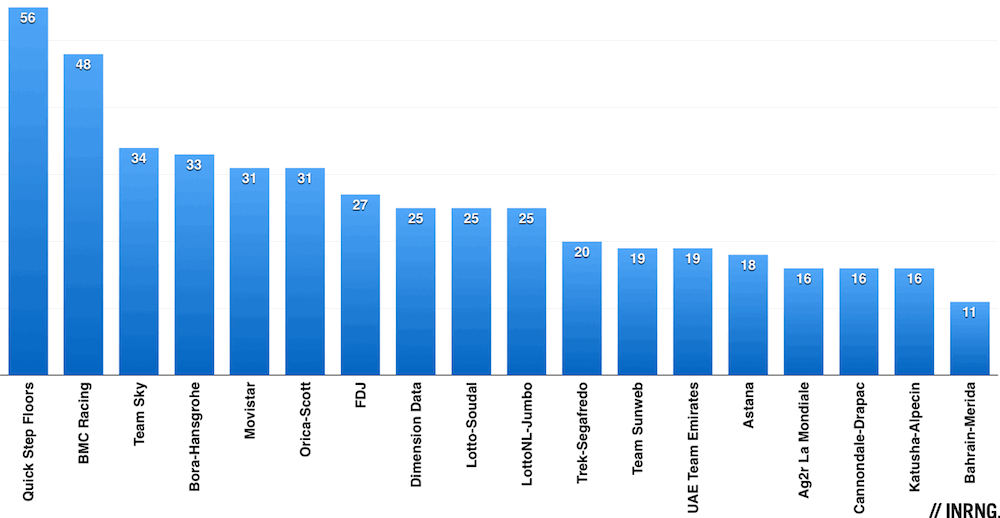
Quick Step top the table just as they have every year since 2012 and their best year was 2014 with 61 wins. BMC had overtaken them at the previous count but the Belgian team reclaimed its habitual position thanks to an Indian summer led by Matteo Trentin and Fernando Gaviria. The most victorious riders in the peloton for 2017 were Marcel Kittel and Fernando Gaviria with 14 wins each which helps explain Quick Step’s many wins but only accounts for half of their tally and 14 of their 29 riders won during 2017. The team are able to win on every terrain with a bias to prefer flat country or at least flat finishes although Julian Alaphilippe and Dan Martin each took a summit finish.
BMC Racing came close and surprisingly their most prolific rider was Dylan Teuns with eight wins ahead of Greg Van Avermaet on seven with Richie Porte and Rohan Dennis on six wins each. Movistar finish fifth and seemed to run out of steam in the summer, their last win dates from the Vuelta a Burgos at the start of August and they looked adrift at the Vuelta. Team Sky are third and they’ll miss Elia Viviani who moves to Quick Step and has been their most prolific rider and there’s no direct replacement even if U23 World Champion Kristoffer Halvorsen is a promising sprinter although he could well turn out to be a classics contender.
At the foot of the table Astana haven’t got the results to match their budget but it’s been a tough year with the death of Michele Scarponi. On the racing front they will be satisfied with the quality, a stage win and a spell in yellow in the Tour de France with Fabio Aru and two stages of the Vuelta thanks to Miguel Angel Lopez who will be crucial to their hopes in 2018 given they’ve lost Aru. For years Astana would outbid others in the transfer market, now UAE Emirates have done it to them by poaching away Fabio Aru. Ag2r La Mondiale didn’t win much but struck when it mattered thanks to Romain Bardet’s stage win at Peyragudes in the Tour de France and his podium place in Paris which will had the team sponsors purring and pumping out their annual press release that their sponsorship returns publicity worth several times their spend. If Bardet keeps improving – his Tour podium was down to consistency rather than a coup d’audace – the team are very reliant on him, more so now Domenico Pozzovivo leaves for Bahrain-Merida in 2018.
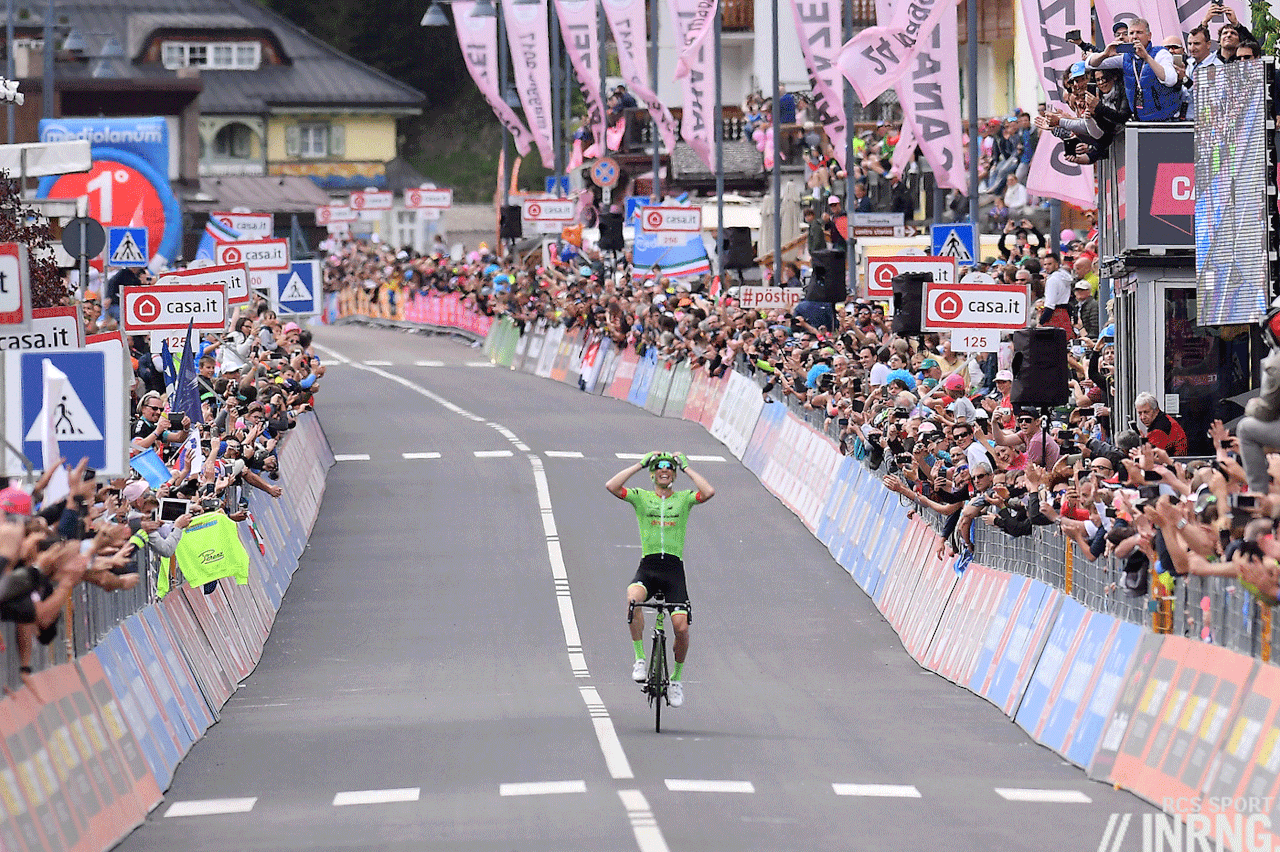
Cannondale-Drapac’s financial woes have been well known and probably compounded by the team’s performance on the road, results have not been seductive to sponsors. 2017 was actually a relatively good season as they took World Tour wins for the first time since 2015 with important wins from Andrew Talansky in California and Pierre Rolland in the Giro and above all Rigoberto Urán won a stage in the Tour de France on his way to second overall, a huge result that with hindsight probably keeps the team on the road. Once glance at the chart helps tell us why Katusha-Alpecin have hired Marcel Kittel, they’re a big budget team with few results. Ilnur Zakarin improves but had no wins except the Russian TT championships and they didn’t win a grand tour stage or a monument classic, only four wins in the World Tour and two of these in the lesser-status “new” World Tour events. Bahrain-Merida are last but will point to two grand tour podium finishes thanks to Vincenzo Nibali and seem a classic Italian team built in the service of one leader, with Sonny Colbrelli popping up for a few sprint wins.
Now to look a little deeper into the stats…
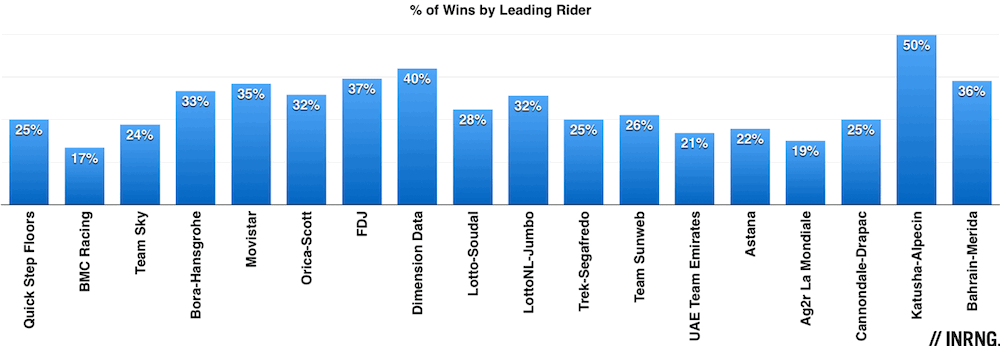
The chart above shows the share of each team’s wins by its lead rider, in other words how dependent a team is on one rider to bring in the wins. Katusha-Alpecin stand out with Alexander Kristoff taking half their wins in 2017 and Edvald Boasson Hagen and Arnaud Démare are the key riders for Dimension Data and FDJ respectively. It helps illustrate how dependent some teams can be on one rider for wins but interestingly we might think of Bora-Hansgrohe as “Team Sagan” and he certainly makes up a lot of the squad’s budget but ten riders won races in 2017.
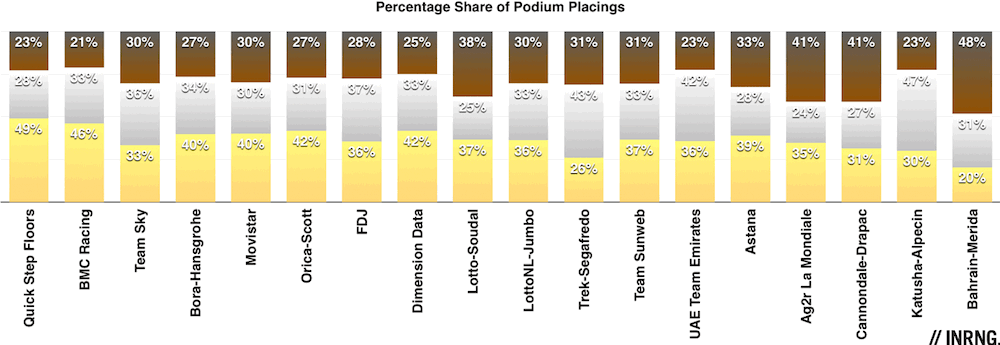
This chart shows the share of each team’s podium places with gold, silver and bronze to depict first, second and third places. Normally you’d expect an even distribution but in 2017 some teams struck gold disproportionately, notably Quick Step who if they had a podium finisher then almost half the time it was a winner. Conversely Trek-Segafredo were the nearly men of 2017 with 43% of the podium finishes in second place while Bahrain-Merida had 54 podium places but only 11 wins.
Pro Continental Teams
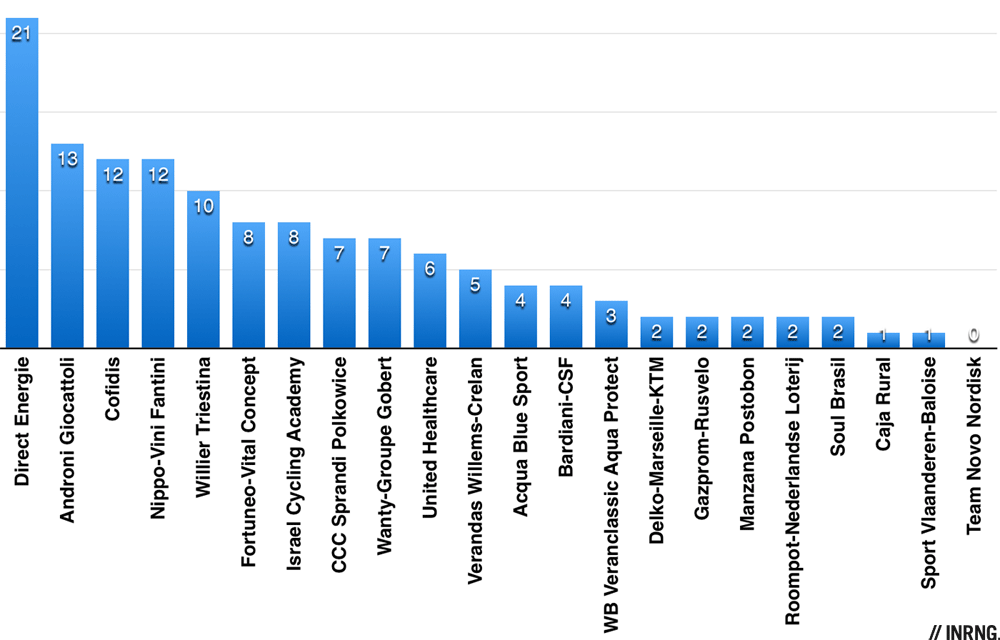
Among the Pro Conti teams Androni-Sidermec had 25 wins at first glance but some of these were Egan Bernal’s Tour de l’Avenir win when he was riding for Colombia and more were in lesser 2.2 races which are not counted here. So the actual figure is 13 wins which leaves Direct Energie as top of table. They hit the jackpot with Lilian Calmejane’s stage win in the Tour de France, a big win for the small team and even better it came on a weekend when TV audiences in France peak and after Calmejane had gone solo ensuring beaucoup airtime but they lose their key rider Bryan Coquard for 2018. Cofidis have just sacked manager Yvon Sanquer for poor results, something they’ve done to Alain Bondue and Eric Boyer before. They can sack managers because unlike most teams the sponsor actually owns the squad rather than the manager. 12 wins is modest for a €10 million budget, they haven’t won a Tour de France stage since 2008 and only had one World Tour this year and if Nacer Bouhanni was KO following his concussion sustained in the Tour de Yorkshire they struggled to channel their sprinter both before and after, for example Bouhanni bailing at Paris-Nice and the team employing his father in order to help calm him. At the foot of the table Novo Nordisk have no wins but for them participating is really a success, to show those with diabetes what can be done.
Overall cycling’s second tier is far removed from the World Tour with just four World Tour wins among all the teams, two for Aqua Blue thanks to Stefan Denifl’s wunderbar Vuelta win and Larry Warbasse’s breakaway raid in the Tour de Suisse, Nacer Bouhanni in the Volta Catalunya for Cofidis and Calmejane’s Tour stage. In short these teams may earn wildcard invites to the top races but they’re present to liven up the race and get their jersey on TV but winning is highly improbable.
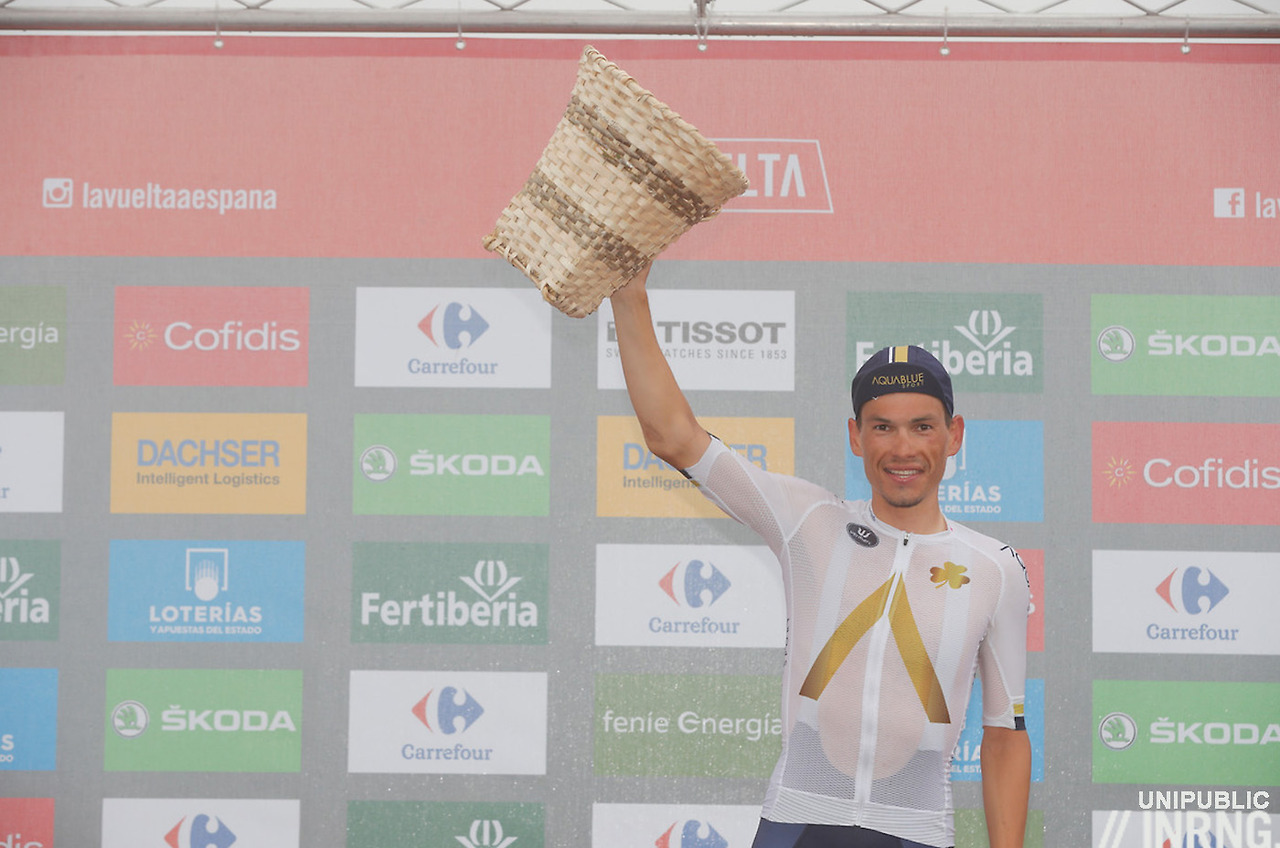
- Methodology: wins are in *.1 races and above and when the rider is wearing riding for their team, eg Peter Sagan’s Worlds win is not a triumph for Bora-Hansgrohe; nor were Elia Viviani’s two wins in the Tour of Austria for Team Sky because he was riding for the Italian national team. Ancillary prizes like points competitions, mountains jerseys don’t count.

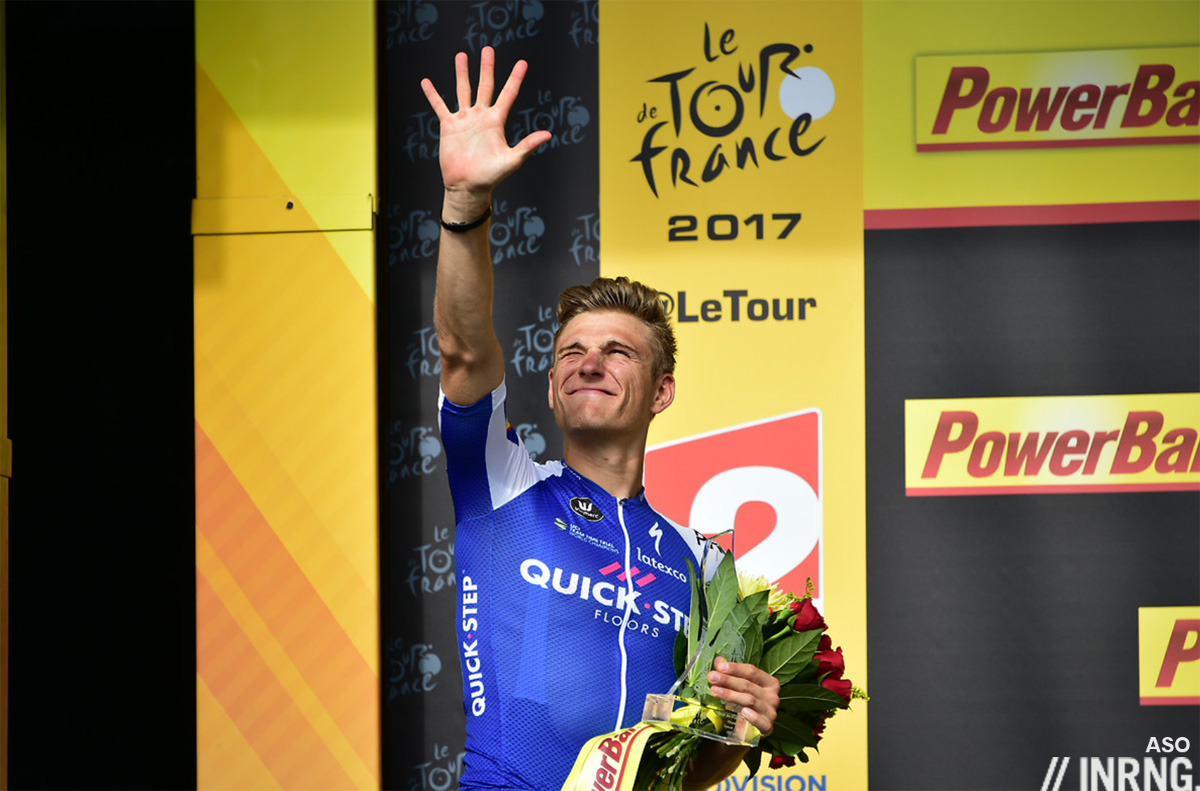
Photo at the top of the article makes it look like INRNG has some publicity on the Tour podium. About time too! 🙂
I do believe that is just a “watermark”
I thought Viviani is movino to Quickstep next year?
You’re right, remembered that the reported UAE Emirates deal didn’t happen… forgot the QS move.
Isn’t Astana’s big budget a thing of the past or, at least, not the present? Vino interviews can’t always be trusted or the translation loses something but the Expo promotion push is over and they need to Kazakh riders to come through at the expense of developing Italian riders. Minali aside.
Interesting to see how Bahrain push on next year, made some interesting retention choices in relation to the budget and perceived direction. Not entirely clear about Cink, had some knee issues but odd they took him to the Tour to get him GT experience and now not on their roster for next year. I might have missed the story.
Pro-Conti wise, rankings make me hope that Nippo-VF get a Giro Wildcard. I know the selection committee doesn’t find them an exciting prospect and Cunego is, if not over the hill, then struggling to get up it as quickly as he used to but Canola has been good all season. No failed doping tests as a team and have to be at least the equal of Wilier, unless Pozatto’s tats are taken into account. The overall Italian-Japanese concept doesn’t quite gel but they’d have to consider their approach if they get passed over for any of the others.
You could be right about Astana, they’re bringing several domestic riders along but re-signing Fuglsang at his peak probably didn’t come cheap nor did others like L-L Sanchez.
Cink was taken to Bahrein-Merida by Merida on the back of his MTB contract falling away but can revert back to MTB again so he’s off, presumably with an eye on Tokyo 2020 now. As for Nippo-VF they don’t have a must-have rider to sway RCS and will find it hard up against Aqua Blue who are capable of winning a stage.
Mauro Vegni has shown the last two years that he couldn’t care less whether or not a team has a must-have rider. Cash is king when it comes to a wild-card invitation to the Giro.
Lotto Soudal weren’t able to count on Andre Greipel to deliver the big wins as he admits he “lost his radar”, and kept coming up short, breaking his previous run, from 2008 I think, of always winning at least one stage in a grand tour per year. I wonder how much of this was down to the loss of his key leadout man Greg Henderson?
Interesting stats. Even WT races are not equal. I would hate to see an attempt at event rating used because most of us know the events which carry real sporting weight, against those that make up the calendar and those that are there simply because of financial clout.
It probably wouldn’t make much difference to the top 6, but there would certainly be a shuffling in the lower orders.
I had an idea about trying to look the quality of wins on a WT vs .HC vs .1 but thought it would get distorted by the variety of WT races, the World Tour calendar is too disparate.
that’s interesting… we could create one…… everyone will have an opinion and I make no pretence at being an expert in history and prestige but here’s a starter… I’m just basing this in what I’d think Pro cyclists (of any form) would like to have on their palmares
feel free to correct me…
TdF GC
Flanders
Roubaix
Giro GC
Milan San Remo
LBL
Lombardia
GC Vuelta
TdF stage win
Dauphine GC
Paris Nice GC
Tireno adriatico GC
Amstel/gent wevelgem/strade bianchi
SUisse/ romandie GC
E3 fleche wallone
basque/catalunya/california/TDU GC
stage of the week longs
everything else
Gunagxi
missed giro/vuelta stage wins… guess they’d slot in below amstel/G-W/SB
For me any qualitative ranking should be based upon quality of the opposition, not on a percieved importance of a race. For example: It would be far more impressive to beat Sagan, Matthews, Cavendish and Kristoff in a .1 race than just Coquard in a San Remo (yes, not realistic examples but it demonstrates my point).
As long as the biggest riders are racing, it will carry qualitative value. Any separation then comes based on how the race was run. Was it aggressive? Was the weather difficult? Did the winning rider attack or wheel-suck? For example: Gerrans has “big” wins in MSR and LBL, but i wouldn’t rate them as highly as Cancellaras ’08 MSR win, or Gilberts ’11 LBL victory which were hard fought race wins.
In some sports the value of a tournament win is determined by the starting field (or its equivalent). Each athlete has a certain number of ranking points and the higher the sum of all competitors’ points is the more valuable the victory.
This is not only simple but it also rules out the political and the commercial interference: if you can get the top dogs to participate, you have a top category race, but if you cannot, you have at best a middle category race. (But of course the players with political or commerial interests will use their clout to get the top athletes or teams to compete in the events that suit those players’ interests…)
The problem with cycling is that it’s pretty much normal (and once it was even *necessary*) to enter a race in order to train. Or, sometimes, just to poach stages even if he’s got loads of point because he’s otherwise a GC top competitor.
And I’m strongly against the idea of keeping historical value out: and I don’t (necessarily) mean the whole century of history, let’s say at least the last 20 years.
You can get a top dog who for any reason loves a peculiar race and raises its accidental value by participating or winning it, but it does’t reflect the ability of the race *as such* to reward the best riders. You can judge that only keeping track of several winners’ level through the years.
While I agree that Cancellara and Gilbert’s wins are more impressive than Gerrans’ (keep in mind, in his MSR and LBL wins he beat exactly those guys and, while we’re at it, why haven’t those two won both LBL and MSR themselves? but hey) you can only win against the people who show up and race the race as it unfolds. Unless you’re Merckx; and you’re not.
Winning the Giro GC changes a rider’s career way more than a Flanders or Roubaix win, any pro rider would prefer the former if he actually could choose… but truth is that most Flanders or Roubaix pretenders can’t even dream to win more or less any GC nowadays (and the other way around), so it’s hard to compare.
The quantitative impact on general public is equal in Giro’s and Roubaix’s case, even if it’s less evenly distributed around the world. The Giro is being watched by way more spectators in core cycling countries, but the Roubaix is watched by more viewers who otherwise aren’t cycling fans at all (which is good in a sense, but awful from several other POVs, especially in a historical moment when cycling is growing as a practised sport more than as a TV show).
The Flanders has even less media impact, but it’s highly esteemed within cycling world because of its highly selective nature which tends to reward quality riders more than other Classics.
If we have a look at the last 20 years or so, since 1997 (leaving history aside for a moment), we’ll easily notice that the Roubaix was often won by riders who never won or podiumed in any other Monument or GT: Hayman, Knaven, Bäckstedt, Vansummeren, Guesdon barely made any other top-ten, if anything; then you have second-line riders like O’Grady or Terpstra who podiumed in other Monuments but who apparently can’t do best that their single big win (Terpstra still has time, indeed).
More than 30% of victories by mediocre (very relatively so…) riders is something that makes the race less interesting from a purely technical POV, although it’s magic is hard to match.
In Flanders you don’t even have the sort of casual winners which fill nearly 20% of Roubaix’s recent palmarés. The “second-line” winners at least podiumed in other Monument once or more than once: Wesemann, Nuyens, Bortolami is the closer you can get, and one might add Devolder who won the race twice but without ever podiuming elsewhere. The rest are huge quality winners, with a notable percentage of World champions: only 2 World Champions, Boonen and Museeuw, won the Roubaix, 5 different World champions won 7/21 Flanders.
LBL sits somewhere in the middle: a couple of casual winners (both very recent), namely Poels and Iglinsky. Hamilton and Vandenbroucke didn’t win much else in terms of very-very-very top races, but they podiumed big elsewhere. And I struggle to include FVDB among “second-line” winners. Three separate World champions won 4 editions (plus an Olympic champion 😉 who won a couple more), but in the case of multiple winners Valverde and Bartoli you can see they do really have a tendency to come close to those elusive Worlds.
Liège is declining in recent years in terms of world audience, but it’s still above Flanders.
I’d say that a combination of world impact and technical values would place RVV, P-R and LBL on the same level. Sure, LBL has been a poor show since 2013, but the previous 4 editions had been excellent, a consecutive streak of great racing which the other Monuments don’t match in recent years. And the 1997-2007 decade had been great, too, with few exceptions, probably averaging better than the two late Spring colleagues.
The Lombardia show the same average technical level as LBL since 1997, but – as easily expected – it’s *even better* in recent years. OTOH, its media potential is growing but limited, still back when compared to the Spring races.
The Sanremo looks just a little better than the Roubaix from a technical POV (3 “casual winners” and a couple of second-line ones). And yet… 7 editions have been won by 4 different World champions. Significant. However, unlike the Lombardia, the technical trend is not very convincing in the last decade: conversely, media figures are on the rise.
The top of the chart should probably look like this (again, I’m considering both technical value and media impact):
TdF GC
Giro GC
RDV, P-R, LBL
Lombardia, Sanremo
Vuelta GC
The rest is a huge mess, mainly the result of English-speaking media pushing up the races which their national riders decide to win (while the rest of the pack is riding those as a mere preparation…) – a decision which is more often than not determined by political relations with ASO. I’ll give it a further look later.
to help complicate matters, Worlds results and days in a GT leader’s jersey should also factor in, no?
Ah ah ah, yeah. But – no.
Days in leader’s jersey make very little sense.
They mean you’re doing extra effort for media duties and controlling the race (with its advantages, too…) but truth is that despite more recent approaches – Nibali, Froome – which made even more extreme the Hinault-Indurain-Armstrong trend (but then, it also depended on the formulaic position of long ITTs), many GT champions’ style wasn’t about taking the jersey ASAP and defending it.
Speaking of the TdF, I believe that Bobet or Koblet, in the far past, weren’t like that, but also LeMond, Fignon, Roche would be penalised by such an approach, just as Contador, Gaul, Pantani…
Coppi wore the jersey the same days as Nibali – winning the double of Tours.
It’s too much of a random factor, and you end up including the Voeckler, the Steve Bauer, or some sprinters (several are already in as Monument or Worlds winners!).
Besides, given the trend of recent years, adding this stats wouldn’t change pretty much anything.
Most jersey wearers are already included because of their podia in some GT, several others, those who may succeed in wearing the jersey during the first weeks, are often Monuments or Worlds winner (Worlds road race is included). And the stage race winners who couldn’t ever podium in a GT… normally didn’t wear much of a GT jersey at all. OTOH, GT jersey wearers without other qualifications didn’t win these important short stage races, either.
Take Voeckler: even if I added him for his yellow jerseys, he wouldn’t contribute to any stats about the above listed stage races. Same goes for Steve Bauer, a very good rider, but… he never won any of the above (he came close to the TdS), hence including him wouldn’t change nothing… even if he was in the correct time frame. Huge statistical effort with poor impact.
If anything, maybe you’d just get sort of a *French bonus* for the Moreau of this world (2 days in yellow make of him a top rider?).
Since the riders are divided according to a binary categorisation, it’s also important to keep a consistent concept of what is “high level”.
I’ll conced that Cancellara is a great rider and can be considered as a worthy high level winner (but he’s already included thanks to his Monuments, no need to look for his yellow jerseys). Yet, I wouldn’t find it appropriate to throw in the same mix Triki Beltrán with the Froome, Valverde, Nibali, Purito, or even Daniel Martin, Cancellara, Sagan… because he wore the Vuelta jersey three days in 2004. He’d make the Catalunya stats better, yes, but – so what?
Do you really think that Vuelta a Burgos is worth becoming top level (6/1) thanks to Dani Moreno having been leader of the Vuelta one day in his whole career or because Juan Carlos Domínguez won the Giro 2002 Prologue by 1 sec. and hence was leader for one day (he lost 25″ in the following flat finish and Cipollini got pink)?
Leader jerseys are essentially a curiosity, not a proper statistical indicator, especially in this case when the changes they’d introduce would make the sample less representative, not better.
The Worlds are already in but *only* the Road Race, for similar reasons. Nobody considers a four time winner of the ITT rainbow (T. Martin, Cancellara) as the “most winning rider in World Championships”. That’s Sagan, Freire, Merckx, Rik I and Binda. At three each. Full stop.
Sure, several of these ITT rainbow guys have won short stage races, but, to me, just the ITT Worlds is not enough to make you first category. If you’ve got some other skills, you’ll end up winning something else like Cancellara, Wiggins, Dumoulin, Ullrich, Honchar, Olano, Jalabert, Zülle (all *already* included in my stats).
I’m especially sorry for Rogers, but, hey, his best results in GT were 9th (TdF) and 6th (Giro). He didn’t ever came close to the podium, and anyway he’d add only to stats of TDU or California which are pretty much beyond salvation. Kiryienka or Grabsch would have no impact whatsoever.
At the end of the day, it’s about Santiago Botero (2005 Romandie) and Tony Martin (2010 Eneco, 2011 Pa-Ni) being factored in or not. Tony Martin has no effect on the general situation, Botero would just confirm a good trend of Romandie in recent years: but truth is that none of them looks on the same level of the above listed names.
Again, we’d make an effort to get a worse sample.
Hummm… Sorry, I thought you were speaking of short stage races. But it’s more or less the same, anyway.
Let’s have a look at how many editions were won by riders who didn’t *ever podium* in a GT nor ever win any Monument (or Worlds), through some of the best shorter stage races since 1997.
País Vasco = 4 (0 in the last decade). Strong race and rising.
Tirreno-Adriatico = 4 (1 in the last decade). Strong race and rising.
Suisse = 6 (4 in the last decade). Huge tradition – it was “the 3rd *real* GT” before the Vuelta got its status – and strong until recent years, but weak last decade.
Romandie = 7 (2 in the last decade). Good tradition, but 30 very weak years from ’80s to 2000s all included, recently on the rise.
Dauphiné = 9 (3 in the last decade) – Decent tradition (1963-1983 its 20 golden years). Recently Froome & Wiggo constitute 42% of high level victories, 50% if you sum up Lance. Race on the rise, still not priming despite of that.
Catalunya =10 (4 in the last decade). Traditional race with huge tradition but weak year 2000s. Recently on the rise.
California = 6/12 yrs (5 in the last decade). New race, ups and downs. Still not at a serious level.
Paris-Nice = 11 (7 in the last decade). Free fall.
TDU = 13/19 yrs (7 in the last decade). Fun.
ENECO Tour 15/18 yrs (8 in the last decade). Working hard to make it good, it had fine editions.
In media terms, Dauphiné, Tirreno and Pa-Ni are the best.
Then you have Catalunya, País Vasco and Suisse.
Then Romandie and ENECO.
Then the extra Europe races.
A classification taking into account technical value (1997-2017), recent trends, media and tradition might be:
1) País Vasco, Ti-Ad
2) Dauphiné, Suisse
3) Catalunya, Romandie, Pa-Ni
4) The rest
If we considered starting list instead of winners, which is not a great idea because you don’t take into account the riders’ attitude in participating (see reply to Eskerrik Asko above), we could give – with 2017 data (another big problem: how do you follow up year by year?) – a bonus and hence push one step up Dauphiné, Pa-Ni and Ti-Ad, one step down for País Vasco, Romandie and ENECO. Note how that simply reflects media figures, which is why I don’t think it makes sense to develop this approach since it makes media impact – and ASO increasing political pressures – count twice. But that doesn’t necessarily makes for a better race with better winners. However, we’d nearly have a one-by-one classification:
1) Ti-Ad
2) Dauphiné
3) País Vasco, Suisse
5) Pa-Ni
6) Catalunya
7) Romandie
8) ENECO
9) The rest
Errata corrige: Catalunya has the same stats as Dauphiné, 9/3. It steps up in both classifications.
Just to have a term of comparison, the Giro del Trentino (“Tour of Alps”, sigh!) has got only 5 “more modest” winners since 1997, 3 in the last decade. Limited tradition in the further past but it, too, is rich in high value winners. Limited media exposure and hence startlist (not being WT, it’s even worse).
Anyway, it would place high in the classifications above, but… hey, we’ve got the Amgen Cali Tour, the BinckBank (Eneco), the Pologne, Abu Dhabi, Down Under, Turkey: why bother for a race which is just, well, *better*?
Same goes for Vuelta Burgos, 8/2 its stats and, like the Trentino, a relatively short stories soon rich in great winners.
You need a middle term vision, even without speaking of “tradition”, otherwise people just lose perspective because of passing trends, like the training or political preferences of the last star rider, hence, in the current situation, giving more value than it makes sense to winter races like Vuelta a Andalucía (14/4 – and, yeah, ’cause Valverde won it 5 times and Froome 1!) or Tour of Oman (a race I’d like to watch, why not? It usually looks great in the highlights. But despite Froome and Nibali, 3 out of eight editions it had a modest winner – and say thanks to Velits’ Vuelta podium).
Also check how high placed ends up being Romandie, a good race but nothing special, its very recent value mainly depending on Team Sky’s schedule… despite more modest startlist, media, tradition or whatever.
Thanks for the education!!
You’re very polite.
Interesting to speculate on what might change next year. For the WT, QuickStep will need to depend more on Gavira, Cannondale and DD still look light as do Trek without Contador, while the two French teams will be happy with a good TdF placing and stage win. Looking at the tables and seeing Cofidis sack thier manager for lack of results raises questions. How can teams get the wins they need to satisfy sponsors if the budget won’t allow proven winner recruitment and how can riders retain places in shrinking teams: an awkward question leading to temptation around the blurred lines?
Well, I share the worries about shrinking teams and riders losing work opportunities – that will sure need some adjustment. OTOH, the hope is that a smaller team might work fine on a sligthly reduced budget (wishful thinking, perhaps).
I guess that the idea, besides having more open races (we’ll se if that *actually* works in the middle term), is that it becomes less expensive to form a more competitive middle to low level team.
However, Cofidis has got a budget which would place it among the WT teams, and it wouldn’t be the poorest one, either (although it would sit in the lower part of the table). Property’s worries about management might not be totally out of place.
Blurred lines: when we’ve got not money, you tend to jump the *less blurred* lines, if anything. The misty zones are for those with the budget to scientifically exploit them and the opportune influence on those who make the rules or keep watch over. It must be said that the doping of the poor is normally poor doping, too. Nowadays, you rarely see any huge performance by the riders who are being doped *and* caught.
A number of teams have already announced that they will have only 24 riders on their roster. The effect of this on the pro riders is the same as two teams leaving the sport!
The number of employment opportunities in pro cycling will always be limited, but I don’t think it is in the interests of the future or the sport to make that number smaller than it already is. When this phenomenon of shrinking WT teams is taking place simultaneously with several Pro Conti teams ceasing to exist, it is really not the time to be a young and upcoming road cyclist…
Looking through the ProCyclingStats listed rosters for 2018 they range from 27 (Astana, Sunweb, Bora & Trek) down to 19 (EF) and 18 (DD). There might be a few more to pick up and complete but the proven names are all placed now. Even with the reduction in race numbers it’s hard to imagine the core WT programme being completed by some teams if one allows for some injury, some illness, and young riders the teams consider not ready for demanding races. If one considers 24 the minimum requirement then 8 teams still have 21 riders to contract (or announce). Where are they?
Some of this is PR, teams have to tell riders if they have a job or not by late September so the employment of many for 2018 should be settled, it is just not announced yet and explains why some teams stagger the news of each renewal.
I was told 6 weeks back that DDD would release about 8 riders including some Africans, Daniel T among them. They have signed 5 riders and may add a couple more from the development team, so next year will be very similar to current strength. Depending where you pick up data, the information is incomplete. For example, to the best of my knowledge, Thwaites, Morton and King signed 2 year deals for 17 & 18, but 2 of those are still not listed for 2018.
if I were Cofidis, or their manager, I would have sacked off Bouhanni for being far more trouble than he’s worth and signed Barguil. Then they’d have been guaranteed a month in the French sporting media limelight, with the chance of placing in other hilly races.
There is never a guarantee. One can never be sure that Barguil, or another, will repeat, or even approach, in 2018 what he managed in 2017, or that a young rider full of promise will realise that expectation. The most predictable part of cycling is the time trial but for the rest there are just too many variables – unless one is Merckx.
best article of the year. The first question of the article asks, “Which teams had the most podium places but the fewest wins?” The graphs clearly illustrates teams’ winning performances, but does not indicate the number of podiums per team.
One chart shows the number of wins and another the podium positions so I wanted to look at the relative rather than the absolute, eg which teams could place but rarely win. But in absolute terms it is Team Sky with 102 podium finishes and 34 wins.
And just think it all starts again in 80 days. I for one can’t wait.
Mareczko can still overtake Kittel and Gaviria with most wins in 2017 btw
By calendar year, yes. But the UCI classes all races after their Gala as part of the new season, so his wins in Hainan at the moment get classed as 2018.